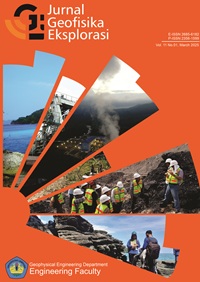STUDY OF ORE MINERALIZATION POTENTIAL IN METAMORPHIC ROCKS IN KAWATUNA AREA, PALU CITY, CENTRAL OF SULAWESI
DOI:
https://doi.org/10.23960/jge.v11i1.484Keywords:
Kawatuna, Metamorphic, Mineralization, Ore, VeinAbstract
The Kawatuna area has a complex geological structure and lithological condition of metamorphic rock, which is estimated to be a weak zone for hydrothermal solutions to rise and then accumulate as mineralization of veins in the metamorphic rock. Based on this, it makes this area interesting to research. This research aims to identify metal ore minerals and the mineralization characteristics of ores in the research area. The method used is a geological survey of the surface and laboratory analysis through ore microscopic as well as mineral chemistry tests. Based on the results of the research study, it was found that in metamorphic rocks in the Kawatuna area, sulfide metal ore minerals were found including argentite (Ag2S), pyrite (FeS2), chalcopyrite (CuFeS2), sphalerite (ZnS), galena (PbS), and covelite minerals (CuS), Native elements ore minerals include gold (Au), silver (Ag), electrum (Au, Ag), and Oxide ore minerals in the form of hematite (Fe2O3). The mineralization formed is controlled by structures that produce fractures in the rock, which then produces mineralization as the veins of metamorphic rocks. The ore mineralization in the research area occurs through a hypogene process (the formation of a formation zone from primary ore minerals) and a supergene process stage (the formation of a formation or enrichment zone from secondary ore minerals).
References
Assidiqi, M., Asrafil, Puspita, R., & Mukaddas, A. (2023). Geological Structure Control of The Distribution Quartz Vein as Mineralization Pathway In Kawatuna Area, Palu City Indonesia. In IOP Conference Series: Earth and Environmental Science (Vol. 1157, No. 1, p. 012022)
Asrafil, Idrus, A., & Djoko Wintolo. (2017). Eksplorasi Endapan Hidrotermal di Daerah Kasihan, Pacitan, Jawa Timur Hydrothermal Deposit Exploration in Kasihan Area, Pacitan, East Java. Jurnal Geologi Dan Sumber Daya Mineral, 18(4), 191–200. http://jgsm.geologi.esdm.go.id
Bemmelen, R. W. (1949). The geology of Indonesia (Vol. 1, Issue 1). US Government Printing Office.
Corbett, G.J., & Leach, T.M., (1997). Southwest Pacific Rim Gold-Copper Systems:
Structure, Alteration, and Mineralization. Short course Manual; Society of Economic Geologists, 235 p
Handayani, T. (2015). Penyusunan Standar Operasional Prosedur (SOP) Preparasi Conto Mineragrafi. Departemen Energi dan Sumber Daya Mineral Badan Geologi Pusat Sumber Daya Geologi, Bandung.
Idrus, A., Sufriadin, & Nur, I. (2011). Hydrothermal Ore Mineralization in Sulawesi: a View Point of Tectonic Setting and Metallogenesis. 26–29.
Leewen, T. M. van, & Pieters, P. E. (2012). Mineral Deposits Of Sulawesi. Geological Agency
Marliani, & Asrafil. (2021). Indication of ore mineralization in Bora Area, Sigi Regency, Central Sulawesi. Journal of Physics: Conference Series, 1763(1). https://doi.org/10.1088/1742-6596/1763/1/012082
Maulana, A. (2020). Endapan Mineral. Penerbit Ombak.
Maulana, A., Broecker, M., & Dan, W. (2020). Petrogenesis and geochronology of Cenozoic intrusions in the Poboya and Sassak gold and copper districts in Western Sulawesi, Indonesia: Implications for the mineralization processes and magma sources. Journal of Asian Earth Sciences, 193, 104303.
Morrison, G., Guogi, D., & Jaireth, S. (1990). Textural Zoning in Epithermal Quartz Veins.
Pertiwi, P., & Jiwandono, T. W. (2021). Analisis Data Resistivitas Dan Polarisasi Terimbas Guna Mendeteksi Keberadaan Mineralisasi Daerah Karangsambung. JGE (Jurnal Geofisika Eksplorasi), 7(1), 71-83.
Pirajno, F. (2019). Hydrothermal Processes and Mineral Systems. Scholars Portal.
Rahman, K., Rasimeng, S., & Haerudin, N. (2017). Identifikasi Zona Mineralisasi Emas Berdasarkan Data Controlled Source Audio-Frequency Magnetotellurics (CSAMT) dengan Data Pendukung Induced Polarization (IP) Di lapangan AU. JGE (Jurnal Geofisika Eksplorasi), 3(1), 3-15.
Rahmaningrum, A. N. N., & Asrafil, A. (2021). ALTERASI DAN MINERALISASI BIJIH PADA BATUAN DIORIT DI DAERAH WOMBO, SULAWESI TENGAH. JGE (Jurnal Geofisika Eksplorasi), 7(2), 138–149. https://doi.org/10.23960/jge.v7i2.136
Sabri, M. M. (2020). Chemical and Structural Analysis of Rocks Using X-ray Fluorescence and X-ray Diffraction Techniques. ARO-THE SCIENTIFIC JOURNAL OF KOYA UNIVERSITY, 8(1), 79–87. https://doi.org/10.14500/aro.10643
Soetoto. (2013). Geologi Dasar. Penerbit Ombak.
Sukamto, R. (1973). Peta Geologi Tinjau Lembar Palu, Sulawesi. Pusat Penelitian dan Pengembangan Geologi.
Sukandarrumidi, I. (2009). Bahan Galian Industri. Gadjah Mada University Press.
Sukandarrumidi, Kotta, Z. H., & Maulana, F. W. (2015). PETROGRAFI; Petunjuk Praktiks untuk Geologis Pemula dalam Mengenal Mineral Berdasarkan Sifat Optik. Gadjah Mada University Press.
Sukandarrumidi, Rakhman, A. N., Maulana, F. W., Purwanti, D. I., & Miftahussalam. (2017). Mengenal Mineral Secara Megaskopis. Gadjah Mada University Press.
Syafrizal, Bhima, & Rivai, T. A. (2020). Vein textures at the Hill Reef Zone, the Poboya prospect, Central Sulawesi, Indonesia. In AIP Conference Proceedings (Vol. 2245, No. 1, p. 070029). AIP Publishing LLC.
Wajdi, M. F., Santoso, S. B., Kusumanto, D., & Digdowirogo, S. (2012). Metamorphic Hosted Low Sulphidation Epithermal Gold System at Poboya, Central Sulawesi: A General Descriptive Review Sistem Emas Epitermal Sulfidasi Rendah dalam Batuan Metamorf di Poboya, Sulawesi Tengah: Tinjauan Deskriptif Umum. In Majalah Geologi Indonesia (Vol. 27, Issue 2).
Downloads
Published
How to Cite
Issue
Section
Citation Check
License
Copyright (c) 2025 JGE (Jurnal Geofisika Eksplorasi)

This work is licensed under a Creative Commons Attribution-NonCommercial 4.0 International License.
Authors/Readers/Third Parties can read, print and download, redistribute or republish the article (e.g. display in a repository), translate the article, download for text and data mining purposes, reuse portions or extracts from the article in other works, sell or re-use for commercial purposes, remix, transform, or build upon the material, they must distribute their contributions under the same license as the original Creative Commons Attribution-NonComercial (CC BY-NC).













